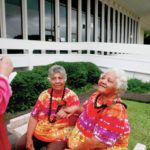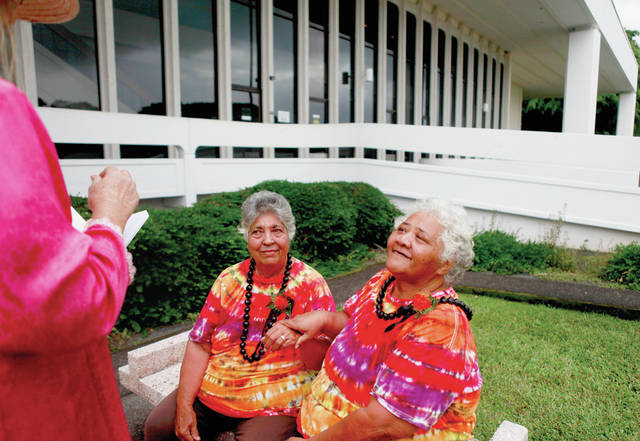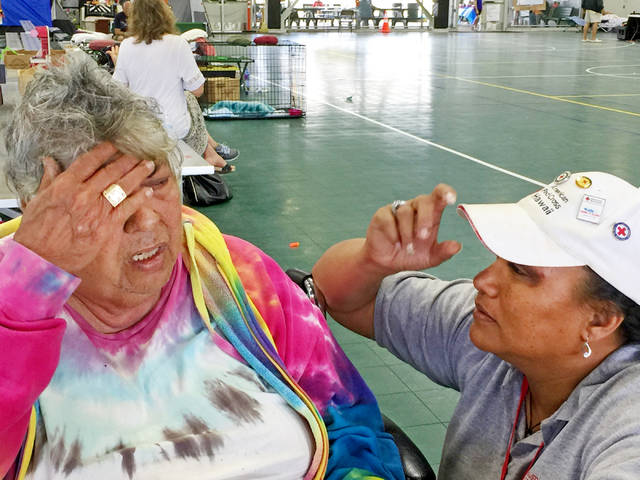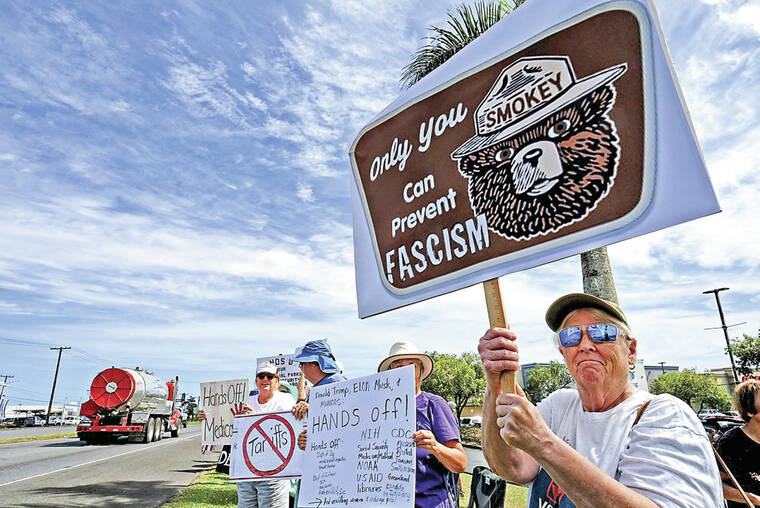Dottie Clopton-Moore and her husband, Tim Moore, of Hawaiian Paradise Park sat near the entrance of the Red Cross emergency shelter at Pahoa Community Center last week, greeting folks as they entered and answering questions.
The pair has been volunteering since the shelter opened earlier this month in the wake of Kilauea’s ongoing eruption
“We just drove to the shelter and said, ‘May we help?’ and there was plenty to do then,” Clopton-Moore said.
Because Red Cross had opened the shelter, the couple was advised to apply to be Red Cross volunteers.
In the first week, Moore said it was a “little unorganized. We were cobbling along as best we could, and as the days progressed, it got to be a little more efficiently organized, and then, officially, it became a need to kind of join the organization, which we thought about earlier anyway.”
The couple has done other volunteer work in the past, but not of this nature.
“We are used to being helpers,” Clopton-Moore said. “We have military backgrounds and believe in volunteering, and wanted to give back to the community.”
They’re not the only ones.
Amy Laurel Hegy, public information officer with the Red Cross, said 300 island residents have signed up to be event-based volunteers, 60 of whom have already gone through training and are working.
An additional 184 already-trained Red Cross volunteers and some paid Red Cross leadership also have been assisting, she said. Of those, 133 are still on the job. Those volunteers are separate from the event-based volunteers.
Maria Lutz, regional disaster officer for Red Cross of Hawaii, said as far as volunteer efforts go, “This is a really tricky event because no one knows what the duration will be.”
There’s no foreseeable end, she said.
“We are looking for volunteers (and are) actively recruiting more local volunteers, especially people who have a lot of availability,” Lutz said. “… We’re really looking for local people to serve their own population because they’ll understand the needs the best.”
Hegy, a volunteer herself, said the important part of any disaster is building the capacity for the next one. They’ve increased the roster of Red Cross volunteers on the island, which means there’s an increased number of trained volunteers who can respond quickly the next time disaster strikes.
“We certainly do have a certain number of people who have come over from the mainland, but you always want to use your community first,” she said. “They know their community. It’s their heart. It’s their home. So they want to participate, and we’ve seen a big outpouring.”
Anyone interested in volunteering can sign up to do so at www.redcross.org.
Relief efforts
continue
As Kilauea’s destruction continues, so do relief efforts to help those affected by the volcano.
The most visible efforts are the emergency shelters open at the Pahoa Community Center, Keaau Community Center and Sure Foundation Church in Keaau, Lutz said.
Relief efforts are going “really well,” she said.
The Red Cross provides different types of support at those shelters.
“So, within these shelters, we make sure clients have access to crisis counselors and spiritual care and health service professionals, which for Red Cross, is usually nurses,” Lutz said.
Hegy said they’ve been honing shelter operations in the weeks since the eruption began.
“The first few days (are) a little bit more chaotic, but all of our community partnerships are bringing so much to the table,” she said. “Like the Salvation Army is doing the feeding, so they’re providing food for all of our shelters, which is an incredible assist.”
And the partnership with Hawaii County and Department of Parks and Recreation has been great, too, providing “wonderful space” in Pahoa and Keaau for shelters, she said. They’ve “been just taking care of the facilities and helping to make everything run more smoothly.”
“There is a lot of coordination and collaboration up at high levels to not only smooth out the current shelters, because we know this may be an ongoing situation, but also to plan for larger evacuations should they become necessary,” Hegy said.
About 200-300 people use the shelters each day. Overall, Lutz said, shelter populations have been holding steady but can ebb and flow, depending on what’s happening.
Some people might leave the shelters because they’re going to relocate with friends and family, or because their transition plans might come to fruition.
Linda de Souza and her wife, Wilhelmina Kamalamalama de Souza, are among those staying at the Pahoa shelter. The couple, along with their two African gray parrots, found themselves there a few days after it opened.
They left their home “out of respect for Madame Pele because she’s taken pretty good care of us, to do what she wants to do with us,” de Souza said.
Kamalamalama de Souza, who graduated from the University of Hawaii at Hilo with a major and two minors earlier this month, also is “fighting a very serious battle with cancer,” de Souza said.
A tent, where Kamalamalama de Souza was sleeping Tuesday afternoon, is set up inside the shelter with enough room for the couple, a friend and their birds.
Because of her health, de Souza said they normally would not have been able to stay at a disaster shelter.
“Typically, it would have gone down that (other organizations) would say, ‘We don’t know how to deal with this,’ but it’s our commitment to make it work for people,” Hegy said.
According to Hegy, the Red Cross’ disability integration, disaster health services, disaster mental health services and sheltering effort “all came together to make this happen for them, knowing that this was just the right thing to do.”
A few days after graduating, Hegy said Kamalamalama de Souza ended up going to the hospital, and when she was released, they wanted her to “come home to the shelter.”
“Who would want to separate them at this time?” Hegy said. “So our team just launched into action and sat down with them to assess what kind of specific needs there might be, and let’s satisfy those barriers to them being together at home in the shelter.”
De Souza told Hegy last week that volunteers “probably underestimate how much people like you help us. I can’t explain it in words, how much more peaceful (it is). And you’ve given us life, and it’s got nothing to do with medical. It’s the way you treated us — nicely.”
Some evacuees, though, have expressed frustration.
April Buxton has been at the shelter for about three weeks and, among other concerns, said tents and cots are not being provided for people who are outside the shelter area.
“My biggest concern (is) they’re not providing things to shelter people from the elements,” she said. “Some people can’t just go and stay inside.”
She and several others have used personal funds to provide tents, blankets, pillows and other items for people.
Lutz said some people choosing to stay outside are just staying on the grounds and aren’t interested in other services provided by the relief organization.
People who come inside the shelter must register as Red Cross clients, but clients also can opt to stay outside.
There are different populations within those staying outside, “so we are helping some of them,” Lutz said, but it’s their choice to register as a Red Cross client or not.
According to the Salvation Army, 9,032 meals were served at the shelters between May 9 and 20.
“As you might imagine, providing emergency disaster services … is very dynamic, with new challenges faced each day as we provide the best response possible for those in need,” said Maj. John Chamness, divisional leader for the Salvation Army Hawaiian and Pacific Islands.
In addition to coordinating meals and other services at the shelter, emergency disaster services personnel and Salvation Army volunteers also oversee a distribution center in Pahoa that provides essential items to those in need.
Located near the pool parking area, the distribution center is open from 9 a.m.-noon and 2-5 p.m. Tuesdays, Thursdays and Saturdays.
Volunteers are needed to sort items and staff the distribution center and to sort donations at the Salvation Army thrift stores in Honokaa, Hilo and Kailua-Kona.
Sign up at hawaii.salvationarmy.org.
To Donate
For the Red Cross, Lutz said monetary donations are best.
They’re the most flexible and better to treat the “ever-changing needs of the relief operations,” she said.
Hegy agreed.
“The Red Cross really operates best with monetary donations,” she said. “We aren’t set up logistically to handle an outpouring of physical items. … However, we don’t turn donations away, should you come up to the door with your donation of whatever it is.”
Donations also can be made at redcross.org.
The Salvation Army also is requesting donations for its distribution center, including blankets, camping chairs, clothing, cots, flashlights, thick outdoor garbage bags, liquid laundry detergents, mats, pillows, single-burner camp stoves, sleeping bags, thick tarps and towels. Donations can be dropped off at the Salvation Army thrift stores in Hilo, Honokaa and Kailua-Kona.
The Salvation Army also seeks large-volume meal donations from local restaurants and certified kitchens. Call 756-0306 for more information.
Food and bottled water donations should be taken to The Food Basket in Hilo and Kailua-Kona.
Email Stephanie Salmons at ssalmons@hawaiitribune-herald.com.











